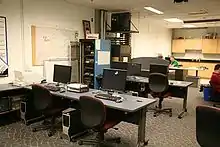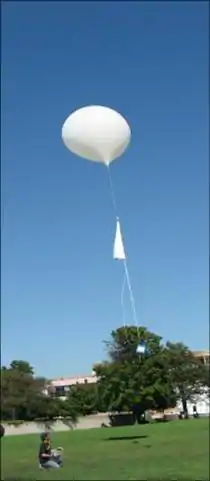Spacecraft Systems and Controls Lab
The Space Systems and Controls Lab is a lab in the Aerospace Engineering Department at Iowa State University located in Ames, Iowa. It is an open and interdisciplanery lab that has research areas in space systems, near space systems, control systems, embedded systems and robotics.
History
The following is an excerpt from the paper "Roots of the SSOL" by Dr. Bill Byrd, ISGC Director and former director of the SSOL:
The SSOL (Spacecraft Systems and Operations Lab) began as a dream in the fall of 1991. At that time, ISU had never conceived, designed, built, tested, and flown a piece of space hardware. There was no facility for faculty or students to conduct such a project. However, a small group of student space enthusiasts was determined to change all that.
Early in 1992, a plan developed to build and operate a small spacecraft for the State of Iowa. The project was called "ISAT" for the Iowa SATellite. Thanks to Dr. Leverne Severiske, work was done in the senior design course, in summer scholarship projects, and in other work supported by the NASA-sponsored, Iowa Space Grant Consortium (ISGC). Since no space was available on campus, an office was rented in Boone, Iowa in the fall of 1992. The students quickly took to the lab and the SSOL name evolved.
The vision for the SSOL was that it become the centerplace for students and faculty who share an interest in space systems. In addition to the required tools for spacecraft design, construction, testing, and operation; the lab was to be a place for students to experience actual space systems before they moved into industry. And so it began.
Unfortunately, the ISAT project was never funded. However, through the work of the original student team, components of the SSOL were found, computers were purchased, parts were donated. Even the City of Boone helped to get things going. Eventually, an opportunity came along to fly an experiment on board the Space Shuttle. One of the old ISAT experiments formed the basis for the development of a new project called IJEMS (Iowa Joint Experiment in Microgravity Solidification). In true ISGC-style, the project involved ISU, the University of Iowa, the Ames Laboratory, the Institute for Physical Research and Technology, Rockwell International, and Space Industries Incorporated. After only four months, the IJEMS flew successfully on STS-69 in September 1995.
In the space of fours, the ISU capability to build spacecraft went from zero to a flight article. The SSOL went from a dream to a hub of activity visited by the likes of University Presidents, Members of Congress, and countless students. More importantly, it was all done by the students themselves. Many of the original students were not around when IJEMS flew on board the Space Shuttle, but it was their work that set the foundation for the successful IJEMS flight.
SSCL Today

In 2007 the SSOL was changed to the Space Systems and Controls Lab as new leadership took over, and to reflect some of the changes the lab had undergone. The SSCL continues with a focus in space systems and has expanded to several new areas. The SSCL still has a strong emphasis in student involvement both with projects and with leadership in the lab. Presently the lab has 4 core projects, two active research projects, several capstone projects and well over 50 students involved from Electrical, Aerospace, and Mechanical Engineering as well as students outside the College of Engineering. The lab is managed by Matthew Nelson, staff within the Aerospace Engineering department and is the Director of Engineering and Operations for the lab. Funding for the lab is from the Aerospace Engineering department, research grants and private donations.
SSCL Projects
The SSCL has several core projects that are ongoing from year to year. In addition to these projects, the SSCL has had numerous capstone and independent projects led by students in the lab.
HABET
The longest running project at the SSCL is the High Altitude Balloon Experiments in Technology (HABET) program. This program has enabled students to design, build and fly spacecraft to the edge of our atmosphere and back to earth. The HABET team has flown experiments that have included micro gravity, the sending of worms, collection of atmospheric data, high quality images and videos and countless other experiments. To date, the HABET team has flown over 130 flights, has obtained an altitude record of 121,793 feet (ASL), has flown payloads up to 50 lbs, and has pushed the envelope in developing new techniques and hardware for High Altitude Balloons.
HABET History

The following is an excerpt from Ralph Wallio on the beginnings of the HABET program in the SSCL:
HABET was started by the Central Iowa Technical Society (CITS) an Amateur Radio organization. CITS launched four HABET flights, HABET-1 through HABET-4, 1993–1994, from the rural home of Ralph Wallio, W0RPK, in north central Warren County. HABET-1 was a traffic load test on a packet radio digital repeater which was developed to fly on STS (this payload did not fly on STS but it began the process that resulted in ARISS today). Flights HABET-2, -3 and -4 included GPS telemetry, Amateur Radio repeaters (23>70 cm) and numerous experiments.
Starting with discussions with the Iowa Aerospace Education Council and with leadership by Bill Byrd, Director Iowa Space Grant Consortium, the HABET program was transferred to Iowa State University and its Spacecraft Systems and Operations Laboratory (SSOL). ISU/HABET-5 (19May95) and -6 (01Jul95) were launched from Ralph Wallio's home as introduction and training flights for ISU students and with funding from the Iowa Space Grant Consortium (ISGC). Following ISU/HABET flights were all managed, designed, assembled, launched and recovered by ISU students from Ames Airport and ISU Ames campus. After HABET was taken in under the SSOL, it became a core project for the lab. Students worked on designing and building the payloads that were used. In addition, students worked hard on making the operations side of the missions safe and effective for all those that were participating. HABET also expanded its payload to not only include amateur radio payloads, but to include other scientific payloads as well. This led the HABET team to have additional students involved from many different departments as well as research flights for faculty and students. HABET has also collaborated with groups outside the university including NASA/Stanford which flew worms up to 100K feet.
IJEMS History
The ISAT project was never fully funded. In September 1994, an opportunity to fly an experiment aboard the space shuttle was presented. One of the original experiments for the ISAT project, was incorporated into a design to be flown aboard the space shuttle in a project called the Iowa Joint Experiment in Microgravity Solidification (IJEMS). The project involved many institutions, including Iowa State University (ISU), the University of Iowa, the Ames Laboratory, the Institute for Physical Research and Technology, Rockwell International, and Space Industries Incorporated. In September 1995, the project was successfully flown on board STS-69.
IJEMS had the following attributes:[1]
- Microprocessor: 33 MHz 486SLC
- Storage Media: 3MB Flash memory formatted with FAT for executable and data storage
- Operating system: DOS
- Thermocouples quantity: 32
- Solid state relays quantity: 24
- Programming language: C++
- Hosted experiments quantity: 4
- Available power: 20A @ 28V
- Pre-flight acceleration testing: 9G
- Smart Can pressure regulation: 1/2 ATM
External links
References
- The Fifth Annual Iowa Space Conference, Conference Proceedings, Iowa Space Grant Consortium., 1995.